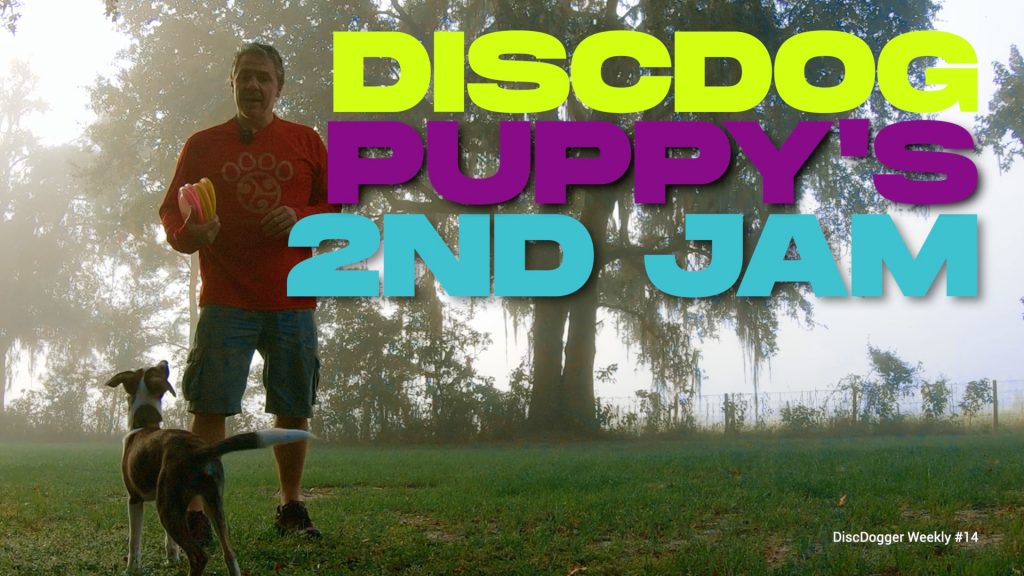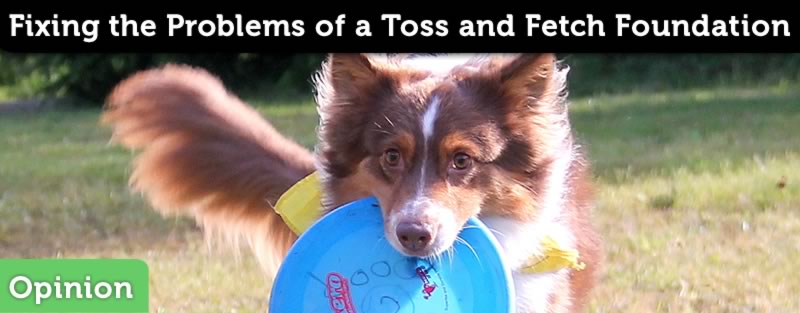
Disc Dog Team Movement Foundation | Puppy’s 2nd Jam
This is Grasshopper’s 2nd jam ever. We did an introduction to disc a few weeks ago that went pretty well. Since then we have done three team movement sessions with cookies (1 | 2 | 3) which included some work on front and rear crosses. There was a total of 17 minutes of work done in those cookie training sessions.
Waiting is the Hardest Part
I had been anxiously awaiting this session from the start of our cookie sessions. This is our standard Set Up Move and Team MovementTeam Movement is how dog and handler move, as a team, out there on the field. It is a judging category in some organizations and certainly is a focus of many judges, players,... More foundation. We have been doing it for 15 years, and I finally got it on video.
The problem with getting our puppy stuff on video is that it happens so darned fast. It is, literally 3 5 minute sessions and the puppy does all the Team Movement skills required of a frisbee dog. It is very hard to capture on film, as we all want to play with the puppy and there’s not much disc stuff you can do with them, so we always wind up doing a session or two without a camera on and ruined the progression from zero to jam.
Before I started the first session, I knew that after 3 cookie sessions he was going to flat out jam with flatwork. And keep in mind, he doesn’t know how to drop, he doesn’t know how to catch, he hasn’t done much bitework, yet I knew he would perform as he did in the video. Done properly, puppies are powerless over our Team Movement Foundation, and this serves as proof of that statement.
Team Movement is More Than Set Up Moves
I used to call the cookie training sessions on this “the Set Up Move Drill“. After all, it teaches all the Set Up Moves Set Up Moves are tricks that are used to establish timing and position in disc dog freestyle. Traditional tricks include: Around, Through, Backwards Through, and Scoot, but any or all of your tricks,... More in both directions in just a few minutes – 9 or 11 Set Up Moves in 5 minutes is nothing to sneeze at… But that is selling the method short.
Set Up Moves are tricks that are used to establish timing and position in disc dog freestyle. Traditional tricks include: Around, Through, Backwards Through, and Scoot, but any or all of your tricks,... More in both directions in just a few minutes – 9 or 11 Set Up Moves in 5 minutes is nothing to sneeze at… But that is selling the method short.
This is a Team Movement exercise that delivers, amongst other things, all your Set Up Moves. To focus simply on the Set Up Moves is to miss the point and miss out on the benefits of doing this exercise. People who already have most of their Set Up Moves or even all of them seem to have no reason to do this if it is just about Set Up Moves. It is the Team Movement, those other things, that make this method special.
Sure, your dog might do Set Up Moves, but does your dog follow your lead while doing them? Can your dog do them at a distance? Do you have complete control over Front Front is a stable position directly in front of the handler. Front is an traditional obedience skill. Usually your dog sits in this position, but standing is often acceptable as well, especially in... More & Rear Crosses? Will your dog do them with discs? Are both directions of each working?
Front is a stable position directly in front of the handler. Front is an traditional obedience skill. Usually your dog sits in this position, but standing is often acceptable as well, especially in... More & Rear Crosses? Will your dog do them with discs? Are both directions of each working?
So I changed the name of the Set Up Move Drill to Team Movement Foundation. Since starting this work with Grasshopper, I realized that even that name doesn’t expand far enough to encompass what this exercise does for a team.
Too Many Variables to Teach
Part of the problem with teaching your dog to play disc is that there are so many elements and angles to the game. You’ve got to teach the dog to have interest in the toy, to bite, to chase, to drop, to move with you, to pay attention, to engage, to wait, and probably a bunch of other things.
But what holds all those things together? What ties them all together?
Without tying them together, the game of disc is ad hoc and potentially very confusing. I think this lack of cohesion and consistency is where teams stumble in the learning process. There are just too many moving parts to manage and to assemble into a complete game that the Team understands.
With puppies, especially, this creates confusion. It creates opportunities for the game to falter and for the pup to lose focus. Puppies are the definition of short attention span theater. Without a framework to tie and hold everything together, there are just too many distractions to deal with. The moment the pup gets confused, it’s on to something else.
Once the pup is on to something else, the handler intervenes and sets up even more variables and further complicates the game.
Sitting on the ground generating interest in the toy by sliding the disc around and shaping that into the game of disc is not a direct path at all. There are so many detours and pitfalls. If you run into them how do you hold it together? More sliding? Calling the dog’s name? What is that doing to and for your disc play other than adding additional behaviors and requirements and detours and pitfalls?
A Cohesive, Consistent, and Holistic Framework of Play
This Team Movement Foundation creates a consistent and cohesive framework that reinforces all the aspects of disc play. This framework holds everything together. Dog and handler know exactly what is required to be successful. We both know how to hit the criteria and hitting the criteria means we’re working together and playing the game. You know, THE game: look at me, move with me, earn your cookie, get your cookie, and do it again.
Starting with cookies initially lays the framework, it sets out clear rules and expectations for the game. Once those rules and expectations are laid, once there is a framework for play, we can start to tap the puppy’s desire to play and work with us to earn cookies and leverage that understanding and desire towards disc.
If we make mistakes or get confused, there is a well worn track or a path to fall back on. A track and a path that both the handler and dog know and understand.
Frameworks Focus and Contain Drive
DriveDrive is focus and energy applied towards work. There are many kinds of Drive: social drive, tracking drive, prey drive, bite/kill, stalking, and food to name a few. Social drive, prey drive, and... More is energy and action applied towards work. If that work has a frame to contain it, then energy and action is easily applied towards work.
If you don’t have a framework of play then there is no game. There is just a bunch of stuff we do. I think this lack of a cohesive framework is the biggest barrier to entry into the game of disc with a dog.
This Team Movement Foundation that was laid on Grasshopper is a strong framework that contains the game and focuses his energy and action towards work.
This is a new realization for me and is a new expression of this training exercise, and I think it’s a big one. I think it could be the secret sauce to teaching the game of disc and solving drive and engagement problems.
Stay tuned as we train up the Grasshopper over the next few months and we’ll see how it goes…








Responses